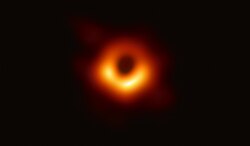Observational history
The comet was discovered by Jean-Jacques Blanpain on November 28, 1819. Blanpain described the comet as having a "very small and confused nucleus". Another independent discovery was made on December 5 of that year by J. L. Pons. Following this the comet was lost, and was given the designation 'D' (Disappeared or Dead).
However, in 2003, the orbital elements of newly discovered asteroid 2003 WY25 were calculated by Marco Micheli and others to be a probable match for the lost comet. [4] On 12 December 2003, it approached Earth at a distance of 0.025 AU (3,700,000 km ; 2,300,000 mi ). [5] Further observations of the asteroid in 2005 by David Jewitt using the University of Hawaii 2.2 m telescope on Mauna Kea, appeared to reveal a faint coma, which supports the theory that 2003 WY25 is the lost comet, or a part of it. [2] The comet was officially established as periodic comet 289P in July 2013, after being rediscovered by the Pan-STARRS survey during an outburst event. [6]
The comet underwent a major outburst in July 2013, when it brightened by 9 magnitudes, one of the largest observed comet outbursts. [7] The comet was first spotted in images obtained by Pan-STARRS on 4 July 2013, having a reported magnitude of about 20, and brightened to a magnitude of about 17.5 and featured a coma about 30 arcseconds across and a broad tail. [6] [8] It is estimated that the comet lost about 108 kg of dust, which corresponds to about 1% of the comet's mass. The comet then was located 3.9 AU from the Sun. [7]
289P was better viewed near and after the 2019-Dec-20 perihelion passage. On 11 January 2020 the comet approached Earth at a distance of 0.091 AU (13,600,000 km ; 8,500,000 mi ). The next close approach will take place on 6 November 2035, at a distance of 0.082 AU (12,300,000 km ; 7,600,000 mi ). [5]
Scientific results
The observations of the comet by the University of Hawaii 2.2 m telescope indicate the nucleus of the comet is quite small. Assuming an albedo of 0.04, which is the mean value for short period comets, its radius is about 160 metres (520 ft), although the presence of coma and unknown phase function means that there is quite some uncertainty. However at that time it was the smallest known cometary nucleus. [2] Observations of the comet in 2019–20 by NEOWISE indicate a rotational period of 8.8536 ± 0.3860 hours or 15.6 hours, with the former being more likely. [3]
The ejected dust masses are 4100 ± 200 kg inbound and 1700 ± 200 kg outbound, respectively, based on the observations by NEOWISE. The dust production rates are Qdust = 0.01–0.02 kg per second, corresponding to a dust-to-gas production ratio of 2 ≤ fdg ≤ 6. The resulting fractional active area, fA = 3.8 ± 1.9 × 10−5, is the smallest yet reported. [3] The absence of 4.6 μm (W2) excess suggests that 289P/Blanpain contains negligible amounts of CO2 and CO. The perihelion-normalized nongravitational acceleration, a'NG = 3.1 × 10−6, is approximately an order of magnitude smaller than the trend observed for well-studied comets, consistent with weak outgassing. [3]
Source of Phoenicids
Comet D/1819 W1 currently has an Earth-MOID of 0.015 AU (2,200,000 km ; 1,400,000 mi ). [5] The comet has been proposed as the probable source of the Phoenicid meteor stream, since the first observation of a Phoenicids meteor storm in 1956. Analysis of the orbits of asteroid 2003 WY25 have supported this conjecture, and it is thought likely that the comet was already breaking up at the time of its 1819 return. [11] The 1956 meteor storm was created by trails formed from the late 18th through the early 19th centuries. [12] Elevated Phoenicids activity was also observed on 2 December 2014, when Earth intersected with dust trails created in the early 20th century, indicating that the comet was then active enough to create meteors but not as active as in the early 19th century. [13]
This page is based on this
Wikipedia article Text is available under the
CC BY-SA 4.0 license; additional terms may apply.
Images, videos and audio are available under their respective licenses.





